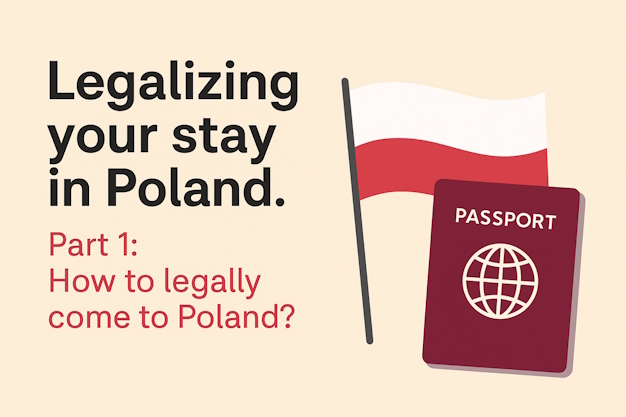Polish rules for legalizing your stay can be confusing. And there are also a lot of misleading and conflicting information on the Internet that can make matters even more difficult.
My goal for this series of articles is to make an overview for the rules that will allow you to plan your arrival and further stay in Poland. This part is about coming to Poland – the very first step.
Is it a visa or a residence permit?
First of all, let’s figure out these two terms. A common misconception is to mix them. They are not the same.
A visa is a document that you can usually only get when you are outside of Poland. It can be issued by a Polish consulate in your home country (or another country if there is no Polish consulate at your home country). There is one exception to this rule – it is possible to apply for a visa extension while in Poland, however it is restricted to only special circumstances.
A residence permit is a document that you can get only when you are in Poland. It is issued by a wojewoda (or “voivode” in English), who is a regional administrator.
So in short: if you not in Poland, you should apply for a visa. And if you already are in Poland, you should apply for a residence permit. Procedures and requirements for each of them are completely different. They also give you different rights.
How can you come to Poland?
With that out of the way, let’s explore ways of getting inside. There are basically 5 options:
- Visa (PL: wiza) – as mentioned above, you can get a visa by applying to a Polish consulate. If there is no Polish consulate in your country, you can apply to a designated Polish consulate located in a different country. Visas can be issued based on different reasons of stay (e.g. work, study, family visit, tourism, etc.). Each reason of stay requires different documents. Also, practices at local consulates may vary, so in order to learn more, you should contact a consulate in your location or use services of a visa agency.
- Visa issued by another country for Schengen area – it allows you to enter Poland, but only for up to 90 days in a 180-day period (i.e. to check if you have any days of stay to use, you should look 180 days back to see if you have any of the 90 days left).
- Residence permit issued by Poland (PL: zezwolenie na pobyt) – if you already hold a residence permit for Poland, you may enter Poland without limitation, for as long as it is valid;
- Residence permit issued by another EU country – it allows you to enter Poland, but only for up to 90 days in a 180-day period (i.e. to check if you have any days of stay to use, you should look 180 days back to see if you have any of the 90 days left).
- Visa-free regime (PL: ruch bezwizowy) – citizens of some countries don’t need a visa or a residence permit to be able to come to Poland and stay here for a limited time without any permits. This is called a visa-free regime (or ruch bezwizowy). It is only possible for citizens of the European Union and for citizens of countries that have signed international treaties with Poland or EU.
Duration of allowed stay without a visa or residence permit is usually up to 90 days in a 180-day period. However, both duration and details of this may be different depending on the country.
Here is a comprehensive list of countries whose citizens can come to Poland without a visa or residence permit:
Albania (only for holders of biometric passports)
Andorra
Antigua and Barbuda
Argentina
Australia
Austria
Bahamas
Barbados
Belgium
Bosnia and Herzegovina (only for holders of biometric passports)
Brazil
Brunei
Bulgaria
Canada
Chile
Colombia
Costa Rica
Croatia
Cyprus
Czech Republic
Denmark
Dominica
El Salvador
Estonia
Finland
France
Georgia (only for holders of biometric passports)
Germany
Greece
Grenada
Guatemala
Honduras
Hong Kong (Special Administrative Region)
Hungary
Iceland
Ireland
Israel
Italy
Japan
Kiribati
Latvia
Liechtenstein
Lithuania
Luxembourg
Macau (Special Administrative Region of the People’s Republic of China)
Malaysia
Malta
Marshall Islands
Mauritius
Mexico
Micronesia
Moldova (only for holders of biometric passports)
Monaco
Montenegro (only for holders of biometric passports)
Netherlands
New Zealand
Nicaragua
North Macedonia (only for holders of biometric passports)
Norway
Palau
Panama
Paraguay
Peru
Portugal
Romania
Saint Kitts and Nevis
Samoa
San Marino
São Tomé and Príncipe
Serbia (only for holders of biometric passports)
Seychelles
Singapore
Slovakia
Slovenia
Solomon Islands
South Korea
Spain
St. Lucia
St. Pierre and Miquelon
St. Vincent and the Grenadines
Sweden
Switzerland
Taiwan (only for holders of passports with an ID number)
Timor-Leste
Tonga
Trinidad and Tobago
Tuvalu
Ukraine (only for holders of biometric passports)
United Arab Emirates
United Kingdom of Great Britain and Northern Ireland
Uruguay
USA
Vanuatu
Vatican City
Venezuela
So, now you are in Poland. What next?
Once you are in Poland and would like to stay longer, you should apply for a temporary residence permit. This can provide legal stay for up to 3 years, depending on the type of permit.
You can find more on that in the next article: https://kancelariakamler.pl/en/legalizing-your-stay-in-poland-part-2-how-to-prolong-your-stay-in-poland-resident-permits/
Would you like to know more? Do you need assistance with applying for a residence permit or need to discuss your future arrival to Poland?
Feel free to contact us and take advantage of our services.

